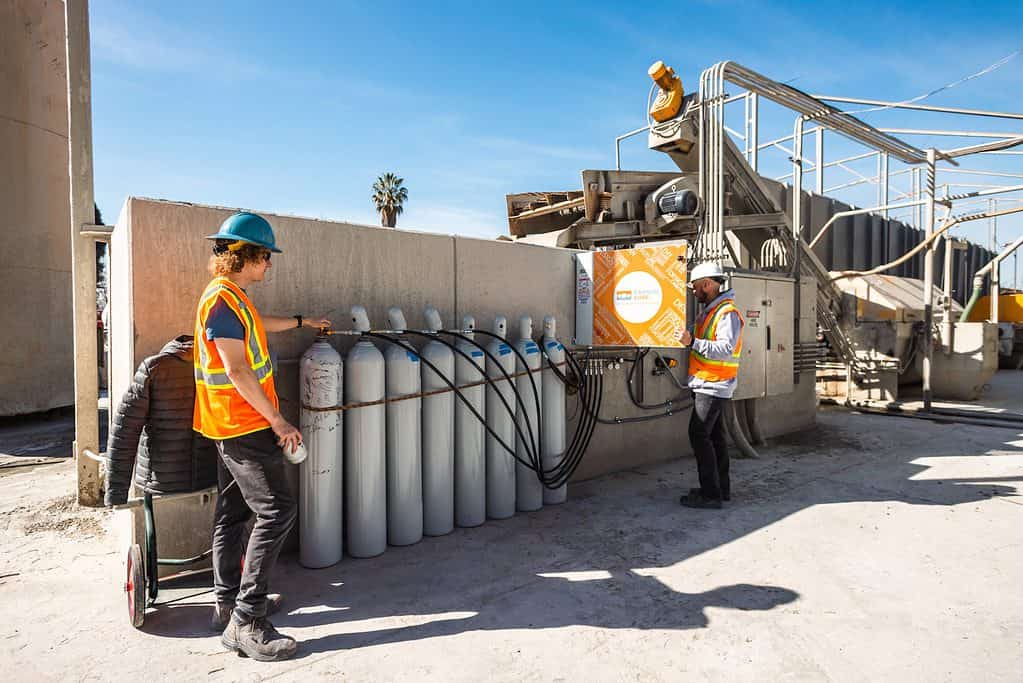It’s one of the most used substances on the planet and a key ingredient in modern cities, supporting essential infrastructure. But concrete is also one of the main drivers of the climate crisis, responsible for about 8% of global carbon emissions. Now, a group of US companies have captured emissions and used them to make concrete, potentially paving the way for more sustainable worldwide engineering.

Concrete is made by adding sand and gravel to cement, whisking the mixture with water, and then pouring it into molds before it dries. Making the cement produces most of the emissions as it involves using fossil fuels to heat a mixture of limestone and clay in an oven. About 600 kilograms of CO2 is released for every ton of cement produced — and in some cases, even more.
Here’s a way of looking at how big the problem with concrete is: if concrete would be a country, it would be the third largest greenhouse gas emitted on Earth, surpassed only by China and the US. Also, there’s no real replacement to concrete, which means we’ll still be producing this key material for years to come; so every method that could help make it more sustainable would be more than welcome.
This is the first time a company was able to capture CO2 from the atmosphere and use it to make concrete for construction projects. While it was a small demonstration project, the hope is that it will help slow climate change by capturing emissions humans have already released and by making concrete in a climate-friendly way.
“This is a global milestone for carbon removal technology that confirms concrete’s enormous potential as a climate solution that can permanently store carbon in our most essential infrastructure – from roads and runways to hospitals and housing,” Robert Niven, CEO of CarbonCure, one of the companies involved in the project, said in a statement.
Cleaning up concrete’s emissions
The project was a joint endeavor, starting with the California-based startup Heirloom. The company uses calcium oxide from limestone to draw CO2 out of the ambient air – a technology known as direct air capture (DAC). Heirloom was funded by Bill Gates’ climate investment fund, which also funded Heirloom’s partner in this project – CarbonCure.
CarbonCure has so far been using CO2 leftover from ethanol and ammonia production to make concrete, some of which was used to build Amazon’s second headquarters in Virginia, as The Verge reported. Now, incorporating Heirloom’s technology, the two companies were able to use CO2 taken out of the air to produce concrete, taking out emissions from the atmosphere.
For their project, the two companies injected CO2 into wastewater and then reused it to make new concrete. They used about 38 kilograms of captured CO2, equivalent to the emissions from driving a car. While this is a really small-scale project, the companies aim for bigger goals, with more funding and tax credits, such as the now introduced by the Inflation Reduction Act.
“The science is clear: In order to reach climate goals we must remove billions of tons of already emitted CO2 from the atmosphere each year,” Shashank Samala, CEO of Heirloom, said in a statement. “This is an important step toward that future and shows the promise of DAC technologies combined with smart, permanent methods of sequestration.”
Capturing carbon on a global scale will require Heirloom and CarbonCure to build massive plants capable of capturing millions or billions of tons of CO2 a year. CarbonCure does not build plants, it licenses its technology to concrete producers and so far, it has licensed 700 systems, saving more than 248,000 metric tons of carbon dioxide from the atmosphere (the equivalent of taking 53,000+ cars off the road for a year) — but this is still only a small fraction when comparing it to the global concrete industry. Also, the price of carbon has to drop for these projects to make sense financially speaking. Heirloom now charges about $1,000 per ton of CO2, Reuters reported.
Leading climate scientists grouped under the Intergovernmental Panel on Climate Change (IPCC) have acknowledged carbon capture will be necessary to meet the target of the Paris Agreement to avoid global temperature increase to reaching 2 degrees Celsius. Efforts such as these are an important step forward but they would have to scale up significantly.
However, scaling the process will prove to be extremely challenging. Cost will be a decisive factor, and if carbon taxes are not included in the mix, then convincing producers to use this method will be difficult, to put it mildly. We also shouldn’t regard this as a silver bullet that can save us from climate change. We should take action to reduce our emissions with the technology we have now, which is totally doable.
This article has been edited for factuality in several parts. The initial version of the article wrongly stated this was the first time CO2 had been stored in concrete. CarbonCure has actually been storing CO2 for several years.






